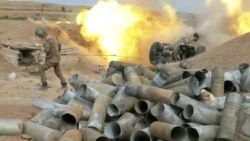The recent outbreak of open hostilities between Armenia and Azerbaijan over the Armenian-controlled enclave of Nagorno-Karabakh has been accompanied by rumors and disinformation.
For example, on Sept. 28, the Armenian ambassador to Russia, Vardan Toganyan, told Russia’s RIA Novosti state news agency that Turkey had redeployed 4,000 Syrian combatants to fight on the Azerbaijani side.
Baku flatly denied the claim.
“Rumors of militants from Syria allegedly being redeployed to Azerbaijan is another provocation by the Armenian side and complete nonsense,” said Hikmet Hajiyev, an aide to Azerbaijan's President Ilham Aliyev.
That is false.
Although the ambassador's claim of 4,000 Syrian fighters is likely an exaggeration, there is considerable evidence that some are there. Reputable media outlets have made contact with Syrian fighters, who have stated that they took part in combat operations. Some appear to be working for a Turkish-owned private security firm.
Some told journalists they were deceived by Turkey, which has been recruiting Syrians. A fighter calling himself “Abdullah” told the BBC that he and others thought they were joining the Syrian National Army, which was formed with Turkey’s support. They were offered salaries as high as $2,000 a month. The recruits found themselves engaged in combat operations in Nagorno-Karabakh almost immediately, however, with no training or understanding of who or why they were fighting. Several Syrian fighters have already been confirmed as killed in action.
Armenian officials are not alone in claiming that Turkey has ferried Syrian mercenaries into Azerbaijan. French President Emmanuel Macron said he received information about Syrian mercenaries at a European Union summit on Oct. 1. He also said Russian President Vladimir Putin briefed him about this during a phone conversation. Macron claimed intelligence reports had established that 300 Syrian fighters had passed through Turkey en route for Azerbaijan.
Macron had earlier criticized both Turkey and Russia, the latter of which backs the Armenians, for supporting opposing factions in Libya’s ongoing civil war. Macron called Turkey’s use of Syrian mercenaries in Libya “criminal.” In response, Turkey accused France of trying to exert influence over the North African country and providing political and military aid to Khalifa Haftar, leader of the Libyan National Army, against the U.N.-recognized Government of National Accord. Macron has denied these allegations, claiming he was seeking a political solution in Libya.
On Sept. 27, open fighting broke out between Azeri and ethnic Armenian forces in the enclave of Nagorno-Karabakh. Azerbaijan and Armenia have accused each other of initiating hostilities and shelling civilian villages in and around the enclave.
Azerbaijan, a Muslim country, is backed by NATO member Turkey. Russia maintains a military base inside Armenia at Gyumri, as well as economic ties to the country via the Eurasian Economic Union, although it has supplied arms to both sides.
On Oct. 2, Armenia said it would be willing to observe a ceasefire called for a day earlier by the Organization for Security and Cooperation in Europe’s (OSCE) Minsk Group, which was founded in 1992 to halt the Nagorno-Karabakh conflict after it first erupted. It is not clear whether Azerbaijan has responded, and as of Oct. 5, combat continues.
The roots of the Nagorno-Karabakh conflict go back to the late 1980s, when both Armenia and Azerbaijan were still Soviet republics. The Armenian-majority territory was located within the borders of the Azerbaijan Soviet Socialist Republic and separated from Armenia proper when the Soviet Union disintegrated in 1991. Fighting broke out in 1992 and continued until a ceasefire was brokered two years later. Since then, Nagorno-Karabakh has been one of several “frozen conflicts” in the former Soviet space, with the Armenian-controlled enclave existing as an unrecognized, self-proclaimed republic.






